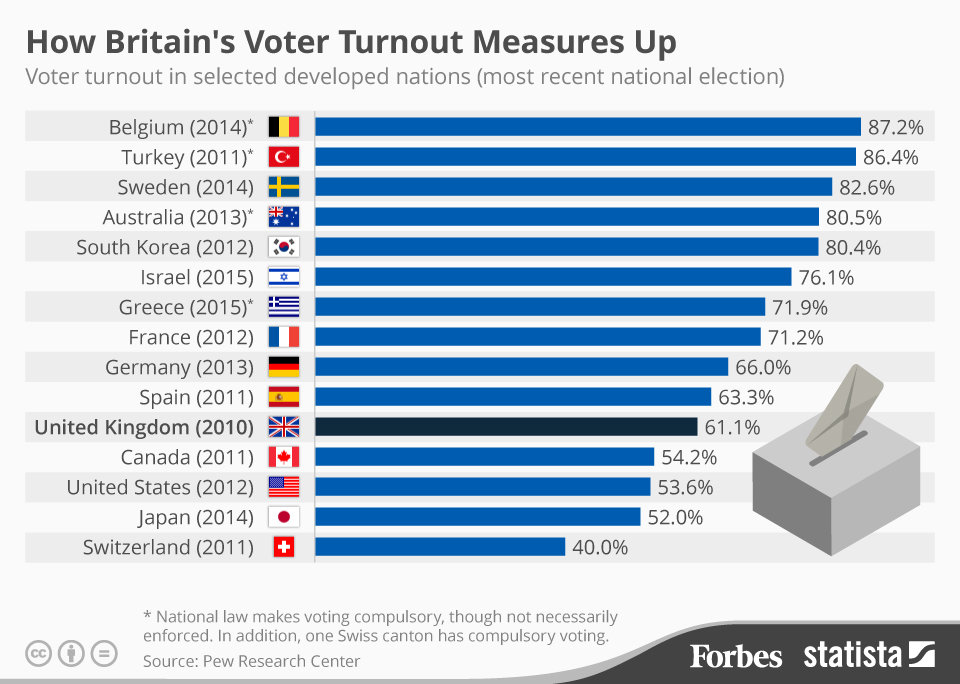Politics through the Lens of Economics
Lecture 8: Condorcet Jury Theorem
30 November, 2016
Masayuki Kudamatsu
Discussion time for written assignment
What evidence do we need to say
the probabilistic voting model explains
The welfare state in Sweden
Publicly-funded healthcare (capped annual fee at 1100 SEK)
Primary, secondary, and higher education for free
Unemployment benefits (80% of income for first 200 days)
Parental leave (80% of income for 480 days)
etc.
Discussion time for written assignment
Aim to fail gracefully
by coming up with wrong answers

Motivation for today
Policies that increase everyone's income
e.g.
Jury trial (i.e. convict those who did commit a crime)
In the previous lectures
we discussed policy issues with conflict of interest among citizens
Today and the following three lectures
we look at policy issues with common interest among citizens
Motivation for today
In the previous lectures
we discussed policy issues with conflict of interest among citizens
Today and the following three lectures
we look at policy issues with common interest among citizens
Today and next week
when no one knows for sure which policy is correct
Lectures 10-11
when politicians' interest conflicts with citizens'

Today's Road Map
Condorcet Jury Theorem
Robustness to Strategic Voting
Evidence

Today's Road Map
Condorcet Jury Theorem
Robustness to Strategic Voting
Evidence
Condorcet Jury Theorem
Majority voting is more likely to choose a "good policy"
than a single person's decision
"good policy" = preferred by everyone
It was a statistical theory
by French philosopher Condorcet
in the late 18th century
to defend the French Revolution

Illustrative Example
3 persons, choosing policies A or B
Policy A is correct (but no one knows for sure)
60% of the time each person can tell which policy is correct
Think of % as how smart or educated each person is
e.g. Amend Article 9 of the Constitution of Japan or not
e.g. Foreign invasion will be prevented by amendment (or not)
1
A
B
60% of the time
single person's decision is correct
40% of the time
wrong
Single person's decision
1
A
B
2
A
B
When person 1 is correct
60% of the time
person 2 is correct
40%
wrong
1
A
B
2
A
B
3
A
B
When persons 1 & 2 are correct
60% correct
40% wrong
1
A
B
2
A
B
3
A
B
Majority voting outcome
A
A
1
A
B
2
A
B
3
A
B
Majority voting outcome
A
A
A
B
60%
40%
When person 1 is correct and person 2 is wrong
1
A
B
2
A
B
3
A
B
Majority voting outcome
A
A
A
B
A
B
1
A
B
2
A
B
3
A
B
Majority voting outcome
A
A
A
B
A
B
B
A
When person 1
is wrong
1
A
B
2
A
B
3
A
B
Majority voting outcome
A
A
A
B
A
B
B
A
A
B
When 1
is wrong
and 2
is correct
1
A
B
2
A
B
3
A
B
Majority voting outcome
A
A
A
B
A
B
B
A
A
B
A
B
1
A
B
2
A
B
3
A
B
Majority voting outcome
A
A
A
B
A
B
B
A
A
B
A
B
B
A
B
B
1
A
B
Majority voting is correct
correct
60% of the time
single person's decision is correct
Majority voting outcome
A
A
A
B
A
B
B
B
1
A
B
Majority voting is correct
correct
60% of the time
single person's decision is correct
Majority voting
is correct
more likely if
is longer
than
Majority voting outcome
A
A
A
B
A
B
B
B
1
A
B
2
A
B
3
A
B
Majority voting outcome
A
A
B
A
These two events happen
with the same frequency
i.e. 60% x 40% = 24%
B
A
B
B
1
A
B
2
A
B
3
A
B
Majority voting outcome
A
A
B
A
B
A
B
B
A
A
Same frequency
(60x40x60=14.4%)
1
A
B
2
A
B
3
A
B
Majority voting outcome
A
A
B
A
B
A
B
B
Same frequency
(60x40x40=9.6%)
B
B
1
A
B
2
A
B
3
A
B
Majority voting outcome
A
A
B
A
B
A
B
B
9.6%
B
B
A
A
14.4%
1
A
B
Majority voting is correct
correct
60% of the time
single person's decision is correct
Majority voting
is correct
more likely if
is longer
than
Majority voting outcome
A
A
A
B
A
B
B
B
9.6%
14.4%
1
A
B
64.8% of the time
majority voting is correct
60% of the time
single person's decision is correct
Majority voting outcome
A
A
A
B
A
B
B
B
9.6%
14.4%
A
B
A
A
A
B
A
B
B
B
9.6%
14.4%
Majority voting is more likely
to choose the correct policy
than single person's decision !
A
B
A
A
A
B
A
B
B
B
This holds true ( is longer than )
as long as each person is correct
more than half of the time
1
A
B
2
A
B
3
A
B
Majority voting outcome
A
A
B
A
B
A
B
B
Wrong
B
B
A
A
Wrong
Correct
Correct
Correct & Wrong
Correct & Wrong
A
B
A
B

Today's Road Map
Condorcet Jury Theorem
Robustness to Strategic Voting
Evidence
Condorcet Jury Theorem assumes "sincere voting"
Each voter votes for the policy that he/she learns is correct
Learning A is correct
Learning B is correct
Vote for A
Vote for B
Economists assume "strategic voting"
with 3 people voting,
your vote matters only when two others vote differently
Voters consider the situation where they are "pivotal"
Both vote for A
One votes for A
None votes for A
A gets majority
B gets majority
Your vote decides
Economists assume "strategic voting"
with 3 people voting,
your vote matters only when two others vote differently
Voters consider the situation where they are "pivotal"
This situation itself
gives you information
To understand this argument
we need to learn a statistical concept used by economists:
Bayesian updating
Today's economics lesson
Bayesian Updating
A
B
Suppose that you believe that policy A is correct
60% of the time
60%
40%
Your initial belief
Today's economics lesson
Bayesian Updating
A
B
Now you examine which policy is really correct
60%
40%
Your initial belief
Today's economics lesson
Bayesian Updating
A
B
60%
40%
A
B
Your learning outcome when A is correct
80%
20%
A
B
Suppose that you discover the correct policy 80% of the time
Your initial belief
Today's economics lesson
Bayesian Updating
A
60%
40%
when B is correct
A
B
A
20%
B
80%
Your learning outcome
Your initial belief
Today's economics lesson
Bayesian Updating
A
B
60%
40%
A
B
Your learning outcome
80%
20%
A
B
A
20%
B
80%
Your initial belief
Today's economics lesson
Bayesian Updating
A
B
60%
40%
B
Suppose you've learned that B is correct
20%
A
B
80%
B
Your initial belief
Today's economics lesson
Bayesian Updating
A
B
60%
40%
B
60x20=12%
A
B
40x80=32%
B
This happens more likely
when correct policy is B
Your initial belief
Today's economics lesson
Bayesian Updating
A
B
60%
40%
B
60x20=12%
A
B
40x80=32%
B
You now believe that B is more likely to be correct
Your initial belief
Today's economics lesson
Bayesian Updating
A
B
60%
40%
A
B
If you learn the correct policy only 50% of the time...
50%
50%
A
B
A
50%
B
50%
Your initial belief
Today's economics lesson
Bayesian Updating
A
B
60%
40%
B
Learning B is correct does not change your belief
60x50=30%
A
B
B
40x50=20%
Your initial belief
Today's economics lesson
Bayesian Updating
A
B
60%
40%
B
If your learning is correct 60% of the time...
60x40=24%
A
B
B
40x60=24%
B
Your initial belief
Today's economics lesson
Bayesian Updating
A
B
60%
40%
B
Learning B is correct changes your belief
when your learning is correct more than 60% of time
60x39=23.4%
A
B
B
40x61=24.4%
B
Your initial belief
Today's economics lesson
Bayesian Updating
70%
30%
A
B
If your initial belief is stronger...
Today's economics lesson
Bayesian Updating
A
B
70%
30%
B
70x30=21%
A
B
B
30x70=21%
If your initial belief is stronger...
B
your learning has to be
correct more frequently
to change the belief
A
B
Suppose every 3 person initially believes
policy A is correct 3 out of 4 times
3/4
1/4
Everyone's initial belief
Consider majority voting by 3 people
A
B
Now each voter examines which policy is really correct
Assume they find the correct answer 3 out of 5 times
3/4
1/4
Everyone's initial belief
Consider majority voting by 3 people
Suppose everyone finds out B is correct
A
B
Suppose everyone finds out B is correct
3/4
1/4
When A is correct policy...
This happens 8 out of 125 times
8 : 117
BBB
A
B
Suppose everyone finds out B is correct
3/4
1/4
When B is correct policy...
BBB
This happens 27 out of 125 times
27 : 98
A
B
Suppose everyone finds out B is correct
3/4
1/4
Initial belief: A is correct more likely
BBB
BBB
Updated belief: B is correct more likely
<
A
Suppose only 2 people find out B is correct
A
B
Suppose only 2 people find out B is correct
3/4
1/4
Initial belief: A is correct more likely
ABB
ABB
Updated belief: A is (still) correct more likely
A
>
Suppose only 1 person find out B is correct
A
B
Suppose only 1 person find out B is correct
3/4
1/4
Initial belief: A is correct more likely
AAB
AAB
Updated belief: A is (still) correct more likely
A
>
Belief switches from A to B
only when all three people learn B is correct
(i.e. Initial belief in A is quite strong)
So in this example:
Optimal voting
When both of the other two vote for A
Majority voting yields policy B, irrespective of your vote
When both of the other two vote for B
Majority voting yields policy A, irrespective of your vote
Your vote is "pivotal"
When one votes for A and the other for B
Case 1
Case 2
Case 3
Focus on what's optimal for Case 3 only
A
Optimal voting
When one votes for A and the other for B
Case 3
You learn A is correct
A
B
3/4
1/4
AAB
AAB
A
>
It's optimal to vote for A
(i.e. Only 1 person finds B is correct)
Optimal voting
When one votes for A and the other for B
Case 3
A
B
It's optimal to vote for A, by ignoring the personal learning
B
3/4
1/4
ABB
ABB
A
>
You learn B is correct
(i.e. 2 people find B is correct)
Optimal voting
When one votes for A and the other for B
Case 3
Whatever learning outcome, it's optimal to vote for A
A
This is true for every voter
Policy A will be the majority voting outcome
even if every person learns B is correct
Condorcet Jury Theorem breaks down !
What if unanimity is needed to adopt policy B?
When both of the other two vote for A
When both of the other two vote for B
When one votes for A and the other for B
Case 1
Case 2
Case 3
Policy B is voted down anyway
Your vote is "pivotal"
Policy B is voted down anyway
Focus on what's optimal for Case 2 only
What if unanimity is needed to adopt policy B?
When both of the other two vote for B
Case 2
B
B
3/4
1/4
ABB
ABB
A
>
It's optimal to vote for A, by following the personal learning
You learn A is correct
(i.e. 2 people find B is correct)
What if unanimity is needed to adopt policy B?
When both of the other two vote for B
Case 2
It's optimal to vote for B, by following the personal learning
B
3/4
1/4
BBB
BBB
<
A
You learn B is correct
(i.e. 3 people find B is correct)
What if unanimity is needed to adopt policy B?
When both of the other two vote for B
Case 2
It's optimal to vote according to your learning outcome
This is true for every voter
Policy B will be adopted
exactly when B is more likely to be correct
(i.e. everyone learns B is correct)
For personal learning to be reflected in voting
the voting rule must be as follows:
When at least m out of n persons find B is correct,
the more-likely-to-be-correct policy switches from A to B
B is adopted if at least m out of n persons vote for B
cf. Article 96 of the Constitution of Japan
"Amendments to this Constitution shall be initiated by the Diet, through a concurring vote of two-thirds or more of all the members of each House..."
Prime Minister Shinzo Abe once remarked:
"It's unfair that just more than one-third of lawmakers could block revisions even if 50 percent or more of the public want to amend the Constitution..."
What we've learned suggests: it's not about "fairness"
but whether the voting rule aggregates information

Today's Road Map
Condorcet Jury Theorem
Robustness to Strategic Voting
Evidence
Do people really vote strategically?
Lab experiments with students at Caltech
Do people really vote strategically?
Lab experiments with students at Caltech
Generalizable to the general population?
Do people really vote strategically?
Lab experiments with students at Caltech
1. Each subject forms a group with 2 others (randomly matched)
2. Each group is ramdomly assigned
either a red or blue jar,
without subjects knowing which


Think of the jar as the correct policy
The blue jar contains 7 blue balls and 3 red balls

The red jar contains 7 red balls and 3 blue balls.

Think of each ball as a personal learning outcome
Your learning is correct 70% of the time
3. Each subject selects one ball, at random, from the jar.
Its colour is then revealed.
4. Each member votes for either a red jar or a blue jar
5. If the voting result is correct, everyone in the group earns 50 cents. If wrong, only 5 cents.


OR
after the voting rule (majority or unanimity) is assigned
Red jar is chosen with 2 out of 3 votes under majority voting
3 out of 3 votes under unanimity voting
B
1/2
1/2
Initial belief: A (blue jar) and B (red jar) are equally likely to be correct
A
Theoretical predictions
B
1/2
1/2
ABB
ABB
A
If two people find B is correct
Initial belief: A (blue jar) and B (red jar) are equally likely to be correct
B
1/2
1/2
ABB
ABB
Updated belief: B (red jar) is correct more likely
A
If two people find B is correct
Initial belief: A (blue jar) and B (red jar) are equally likely to be correct
B
1/2
1/2
AAB
AAB
A
If only one person finds B is correct
Initial belief: A (blue jar) and B (red jar) are equally likely to be correct
B
1/2
1/2
AAB
AAB
Updated belief: A (blue jar) is correct more likely
A
If only one person finds B is correct
Initial belief: A (blue jar) and B (red jar) are equally likely to be correct
B
The correct policy switches from blue jar to red jar
when two, instead of one, voters find red jar is correct
Under majority voting,
voters vote according to their learning outcome
Under unanimity voting,
voters ignore their learning outcome and always vote for red jar
Theoretical predictions
B
Under majority voting
5.7% after seeing the blue ball
97.2% after seeing the red ball
Experimental results
% of subjects who vote for the red jar
Source: Table 3 of Guarnaschelli et al. (2000)
B
Under unanimity voting
36% after seeing the blue ball
95.4% after seeing the red ball
Experimental results
% of subjects who vote for the red jar
Source: Table 3 of Guarnaschelli et al. (2000)
Summary
Majority voting picks the correct policy more likely
than a single person's decision
if the more-likely-to-be-correct policy switches from A to B
when a majority of voters learn that B is correct
People do seem to vote strategically
(i.e. ignoring their own learning outcome if the pivotal situation makes it optimal to do so)
Next lecture
Voter turnout

This lecture is based on the following academic articles:
Austen-Smith, David, and Jeffrey S. Banks. 1996. “Information Aggregation, Rationality, and the Condorcet Jury Theorem.” American Political Science Review 90(1): 34–45.
Guarnaschelli, Serena et al. 2000. “An Experimental Study of Jury Decision Rules.” American Political Science Review 94(2): 407–23.
Politics through the Lens of Economics: Lecture 8 Condorcet Jury Theorem
By Masayuki Kudamatsu
Politics through the Lens of Economics: Lecture 8 Condorcet Jury Theorem
- 1,441



